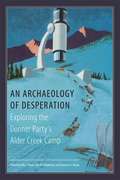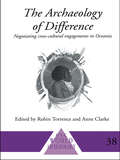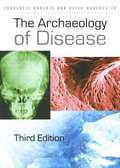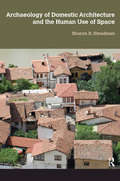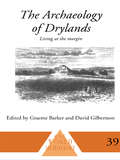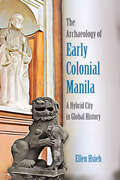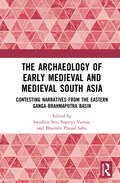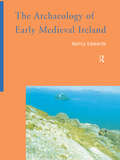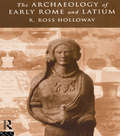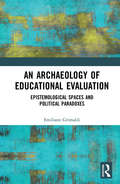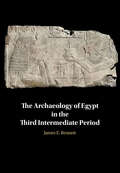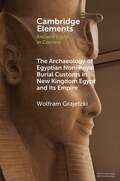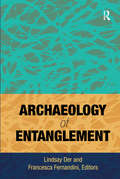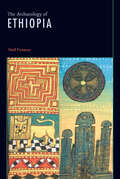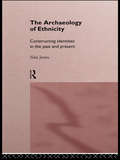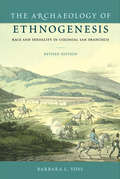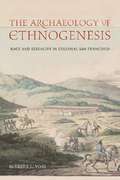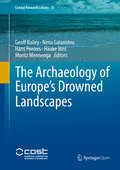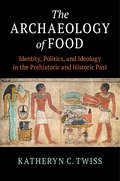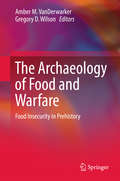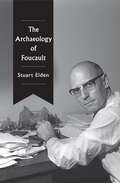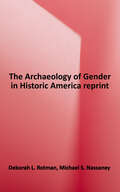- Table View
- List View
An Archaeology of Desperation: Exploring The Donner Party's Alder Creek Camp
by Kelly J. Dixon Julie M. Schablitsky Shannon A. NovakThe Donner Party is almost inextricably linked with cannibalism. In truth, we know remarkably little about what actually happened to the starving travelers stranded in the Sierra Nevada in the winter of 1846-47. Combining the approaches of history, ethnohistory, archaeology, bioarchaeology, and social anthropology, this innovative look at the Donner Party's experience at the Alder Creek Camp offers insights into many long-unsolved mysteries. Centered on archaeological investigations in the summers of 2003 and 2004 near Truckee, California, the book includes detailed analyses of artifacts and bones that suggest what life was like in this survival camp. Microscopic investigations of tiny bone fragments reveal butchery scars and microstructure that illuminate what the Donner families may have eaten before the final days of desperation, how they prepared what served as food, and whether they actually butchered and ate their deceased companions. The contributors reassess old data with new analytic techniques and, by examining both physical evidence and oral testimony from observers and survivors, add new dimensions to the historical narrative. The authors' integration of a variety of approaches - including narratives of the Washoe Indians who observed the Donner Party - destroys some myths, deconstructs much of the folklore about the stranded party, and demonstrates that novel approaches can shed new light on events we thought we understood.
The Archaeology of Difference: Negotiating Cross-Cultural Engagements in Oceania
by Anne Clarke Robin TorrenceThe Archaeology of Difference presents a new and radically different perspective on the archaeology of cross-cultural contact and engagement. The authors move away from acculturation or domination and resistance and concentrate on interaction and negotiation by using a wide variety of case studies which take a crucially indigenous rather than colonial standpoint.
The Archaeology of Disease (Third Edition)
by Charlotte Roberts Keith ManchesterThe Archaeology of Disease shows how the latest scientific and archaeological techniques can be used to identify the common illnesses and injuries from which humans suffered in antiquity. The book contains information on congenital, infectious, dental, joint, endocrine, and metabolic diseases. This fully revised third edition has been updated to and encompasses rapidly developing research methods of in this fascinating field.
Archaeology of Domestic Architecture and the Human Use of Space
by Sharon R SteadmanThis volume is the first text to focus specifically on the archaeology of domestic architecture. Covering major theoretical and methodological developments over recent decades in areas like social institutions, settlement types, gender, status, and power, this book addresses the developing understanding of where and how people in the past created and used domestic space. It will be a useful synthesis for scholars and an ideal text for advanced undergraduate and graduate courses in archaeology and architecture. The book-covers the relationship of architectural decisions of ancient peoples with our understanding of social and cultural institutions;-includes cases from every continent and all time periods-- from the Paleolithic of Europe to present-day African villages;-is ideal for the growing number of courses on household archaeology, social archaeology, and historical and vernacular architecture.
The Archaeology of Drylands: Living at the Margin (One World Archaeology #Vol. 39)
by Graeme Barker David GilbertsonMany dryland regions contain archaeological remains which suggest that there must have been intensive phases of settlement in what now seem to be dry and degraded environments. This book discusses successes and failures of past land use and settlement in drylands, and contributes to wider debates about desertification and the sustainability of dryland settlement.
The Archaeology of Early China: From Prehistory to the Han Dynasty
by Gideon Shelach-LaviThis volume aims to satisfy a pressing need for an updated account of Chinese archaeology. It covers an extended time period from the earliest peopling of China to the unification of the Chinese Empire some two thousand years ago. The geographical coverage includes the traditional focus on the Yellow River basin but also covers China's many other regions. Among the topics covered are the emergence of agricultural communities; the establishment of a sedentary way of life; the development of sociopolitical complexity; advances in lithic technology, ceramics, and metallurgy; and the appearance of writing, large-scale public works, cities, and states. Particular emphasis is placed on the great cultural variations that existed among the different regions and the development of interregional contacts among those societies.
The Archaeology of Early Colonial Manila: A Hybrid City in Global History
by Ellen HsiehA view into the diverse culture of the Philippines in the sixteenth and seventeenth centuries Although Manila, capital city of the Philippines, played a critical role in economic and cultural exchanges between the East and the West during the sixteenth and seventeenth centuries, little is known about what life was like for its residents during this time. In this book, Ellen Hsieh uses archaeological, historical, and ethnographic resources to document the ways Manila was transformed by the arrival of Spanish colonists in 1571 and how the city in turn shaped the modern world. Manila was uniquely positioned as a crossroads in the networks of Southeast Asia, East Asia, and Iberia, resulting in a hybridized culture where colonial Spanish, Indigenous Tagalog, and overseas Chinese groups exchanged goods and ideas. In The Archaeology of Early Colonial Manila, Hsieh analyzes material goods such as ceramics from Intramuros (the Spanish walled city) and Parian (the Chinese quarter) and illustrations from the Boxer Codex—a Spanish manuscript featuring images of people in the Philippines and surrounding areas—to illuminate the diversity of Manila society and to unravel the intricate power dynamics among these ethnic groups. Bridging the gap in research between pre-Spanish and late colonial periods and amplifying the voices of non-elite, diasporic, and colonized communities often overlooked in historical documents, Hsieh provides an important focus on Manila’s contributions to world history during a period of intense globalization.
The Archaeology of Early Medieval and Medieval South Asia: Contesting Narratives from the Eastern Ganga-Brahmaputra Basin
by Swadhin Sen, Supriya Varma, and Bhairabi Prasad SahuThis book looks at the ways in which archaeological methods have been used in debates concerning the early medieval and medieval periods in South Asia. Despite the incorporation and use of archaeological data to corroborate historical narratives, the theories and methods of archaeology are largely ignored in and excluded from the dominating, institutionalized and hegemonic disciplinary discourses. The volume offers contesting insights, polemical narratives, and new data from archaeological contexts to initiate a debate on many foundational premises of archaeological and historical narratives. It focuses on the much-neglected region of the Eastern Ganga-Brahmaputra Basin as a spatial frame to do this, and studies themes such as spatial and temporal scales of concepts and methods, multi-scaler factors and processes of continuity and changes, the settlement archaeology on alluvial landscape, changing patterns of agrarian transformation, and material cultures, including coins, inscriptions, pottery, sculptures, in their contexts in sub-regional, regional and supra-regional intersections. As a crucial and unprecedented intervention in the study of the early medieval and the medieval periods, this volume will be useful for scholars and researchers of archaeology, ancient history, medieval history, water history, earth sciences, palaeoecology, historical ecology, epigraphy, art history, material culture studies, Indian history, and South Asian Studies in general.
The Archaeology of Early Medieval Ireland
by Nancy EdwardsIn the first major work on the subject for over 30 years, Nancy Edwards provides a critical survey of the archaeological evidence in Ireland (c. 400-1200), introducing material from many recently discovered sites as well as reassessing the importance of earlier excavations. Beginning with an assessment of Roman influence, Dr Edwards then discusses the themse of settlement, food and farming, craft and technology, the church and art, concluding with an appraisal of the Viking impact. The archaeological evidence for the period is also particularly rich and wide-ranging and our knowledge is expanding repidly in the light of modern techniques of survey and excavation.
The Archaeology of Early Rome and Latium
by Ross R. HollowayThe archaeology of early Rome has progressed rapidly and dramatically over the last century; most recently with the discovery of the shrine of Aeneas at Lavinium and the reports of the walls of the Romulan city discovered on the city slopes of the Palatine Hill. The Archaeology of Early Rome and Latium presents the most recent discoveries in Rome and its surroundings: princely tombs,inscriptions and patrician houses are included in a complete overview of the subject and the controversies surrounding it.This comprehensively illustrated study fills the need for an accessible English guide to these new discoveries, and in preparation, the author interviewed most of the leading figures in current research on the early periods of Rome.
An Archaeology of Educational Evaluation: Epistemological Spaces and Political Paradoxes
by Emiliano GrimaldiAn Archaeology of Educational Evaluation: Epistemological Spaces and Political Paradoxes outlines the epistemology of the theories and models that are currently employed to evaluate educational systems, education policy, educational professionals and students learning. It discusses how those theories and models find their epistemological conditions of possibility in a specific set of conceptual transferences from mathematics and statistics, political economy, biology and the study of language. The book critically engages with the epistemic dimension of contemporary educational evaluation and is of theoretical and methodological interest. It uses Foucauldian archaeology as a problematising method of inquiry within the wider framework of governmentality studies. It goes beyond a mere critique of the contemporary obsession for evaluation and attempts to replace it with the opening of a free space where the search for a mode of being, acting and thinking in education is not over-determined by the tyranny of improvement. This book will appeal to academics, researchers and postgraduate students in the fields of educational philosophy, education policy and social science.
The Archaeology of Egypt in the Third Intermediate Period
by James Edward BennettThe Third Intermediate Period in Egypt (1076–664 BCE) has been characterised previously by political and social changes based upon the introduction of Libyan social and cultural influences. In this book, James Bennett analyses the concepts of 'transition' and 'continuity' within the cultural and societal environment of Egypt during the Third Intermediate Period and provides an up-to-date synthesis of current research on the settlement archaeology of the period. This is done through the assessment of settlement patterns and their development, the built environment of the settlements, and their associated material culture. Through this analysis, Bennett identifies several interconnected themes within the culture and society of the Twenty-First to Twenty-Fifth Dynasties. They are closely related to the political and economic powers of different regions, the nucleation of settlements and people, self-sufficiency at a collective and individual level, defence, both physical and spiritual, regionality in terms of settlement development and material culture, and elite emulation through everyday objects.
The Archaeology of Egyptian Non-Royal Burial Customs in New Kingdom Egypt and Its Empire (Elements in Ancient Egypt in Context)
by Wolfram GrajetzkiThis Element provides a new evaluation of burial customs in New Kingdom Egypt, from about 1550 to 1077 BC, with an emphasis on burials of the wider population. It also covers the regions then under Egyptian control: the Southern Levant and the area of Nubia as far as the Fourth Cataract. The inclusion of foreign countries provides insights not only into the interaction between the centre of the empire and its conquered regions, but also concerning what is typically Egyptian and to what extent the conquered regions were culturally influenced. It can be shown that burials in Lower Nubia closely follow those in Egypt. In the southern Levant, by contrast, cemeteries of the period often yield numerous Egyptian objects, but burial customs in general do not follow those in Egypt.
Archaeology of Entanglement
by Lindsay Der Francesca FernandiniEntanglement theory posits that the interrelationship of humans and objects is a delimiting characteristic of human history and culture. This edited volume of original studies by leading archaeological theorists applies this concept to a broad range of topics, including archaeological science, heritage, and theory itself. In the theoretical explications and ten case studies, the editors and contributing authors: • build on the intersections between science, humanities and ecology to provide a more fine-grained, multi-scalar treatment emanating from the long-term perspective that characterizes archaeological research; • bring to light the subtle and unacknowledged paths that configure historical circumstances and bind human intentionality; • examine the constructions of personhood, the rigidity of path dependencies, the unpredictable connections between humans and objects and the intricate paths of past events in varied geographic and historical contexts that channel future actions. This broad focus is inclusive of early complex developments in Asia and Europe, imperial and state strategies in the Andes and Mesoamerica, continuities of postcolonialism in North America, and the unforeseen and complex consequences that derive from archaeological practices. This volume will appeal to archaeologists and their advanced students.
The Archaeology of Ethiopia
by Niall FinneranThis book provides the first truly comprehensive multi-period study of the archaeology of Ethiopia, surveying the country's history, detailing the discoveries from the late Stone Age, including the famous 'Lucy' and moving onto the emergence of food production, prehistoric rock art and an analysis of the increasing social complexity that can be obs
The Archaeology of Ethnicity: Constructing Identities in the Past and Present
by Siân JonesThe question of ethnicity is highly controversial in contemporary archaeology. Indigenous and nationalist claims to territory, often rely on reconstructions of the past based on the traditional identification of 'cultures' from archaeological remains. Sian Jones responds to the need for a reassessment of the ways in which social groups are identified in the archaeological record, with a comprehensive and critical synthesis of recent theories of ethnicity in the human sciences. In doing so, she argues for a fundamentally different view of ethnicity, as a complex dynamic form of identification, requiring radical changes in archaeological analysis and interpretation.
The Archaeology of Ethnogenesis: Race and Sexuality in Colonial San Francisco
by Barbara L. Voss“Compelling new evidence, careful documentation, and an artfully woven narrative make The Archaeology of Ethnogenesis a path-breaking book for sociocultural scholars as well as for general readers interested in the politics of identity, ethnicity, gender, and the colonial and U.S. Western history.”—Transforming Anthropology “Voss’s lucid explanations of method and theory make the book accessible to a broad range of audiences, from upper-level undergraduate and graduate students to professionals and lay audiences. . . . Its interdisciplinarity, indeed, may help to sell archaeology to audiences who do not typically consider archaeological evidence as an option for identity studies.”—Current Anthropology “The book reminds historians that other disciplines can offer fruitful methodological forays into well-trodden areas of study.”—Journal of American History “Those scholars studying various aspects of the Hispanic worldwide empire would be well advised to peruse Voss’s work.”—Historical Archaeology “[W]ell written, theoretically sophisticated, and unburdened by abstract concepts or hyper-qualified verbiage.”—H-Net Reviews “[E]ngaging. Overall, the text belongs in the library of every student of Spanish and Mexican Alta California. . . . The Archaeology of Ethnogenesis will become an anthropological standard.”—Journal of California and Great Basin Anthropology “[A] must-read for all interested not only in colonial California, but for all historical archaeologists and to any archaeologist interested in the examination of identities.”—Cambridge Archaeological Journal “Shows how individuals negotiate ethnic identity through everyday objects and actions.”—SMRC Revista In this interdisciplinary study, Barbara Voss examines religious, environmental, cultural, and political differences at the Presidio of San Francisco, California, to reveal the development of social identities within the colony. Voss reconciles material culture with historical records, challenging widely held beliefs about ethnicity.
The Archaeology of Ethnogenesis: Race and Sexuality in Colonial San Francisco
by Barbara L. VossThis groundbreaking work of historical archaeology illuminates the genesis of the Californios, a community of military settlers who forged a new identity on the northwest edge of Spanish North America. Since 1993, Barbara L. Voss has conducted archaeological excavations at the Presidio of San Francisco, founded by Spain during its colonization of California's central coast. Her research at the Presidio forms the basis for this rich study of cultural identity formation, or ethnogenesis, among the diverse peoples who came from widespread colonized populations to serve at the Presidio. Through a close investigation of the landscape, architecture, ceramics, clothing, and other aspects of material culture, she traces shifting contours of race and sexuality in colonial California. The research reveals how these military settlers had cast off colonial classifications within only a few decades, and adopted a new identity as Californios, which in turn naturalized their dominance over Native Californians. An illuminating investigation of one historically significant site in California, the book at the same time shows how historical archaeology can help us understand colonial processes in other settings around the world.
The Archaeology of Etruscan Society
by Vedia IzzetThe late sixth century was a period of considerable change in Etruria; this change is traditionally seen as the adoption of superior models from Greece. In a re-alignment of agency, this 2007 book examines a wide range of Etruscan material culture - mirrors, tombs, sanctuaries, houses and cities - in order to demonstrate the importance of local concerns in the formation of Etruscan material culture. Drawing on theoretical developments, the book emphasises the deliberate nature of the smallest of changes in material culture form, and develops the concept of surface as a unifying key to understanding the changes in the ways Etruscans represented themselves in life and death. This concept allows a uniquely holistic approach to the archaeology of Etruscan society and has the potential for other archaeological investigations. The book will interest all scholars and students of classical archaeology.
The Archaeology of Europe’s Drowned Landscapes (Coastal Research Library #35)
by Geoff Bailey Nena Galanidou Hans Peeters Hauke Jöns Moritz MennengaThis open access volume provides for the first time a comprehensive description and scientific evaluation of underwater archaeological finds referring to human occupation of the continental shelf around the coastlines of Europe and the Mediterranean when sea levels were lower than present. These are the largest body of underwater finds worldwide, amounting to over 2500 find spots, ranging from individual stone tools to underwater villages with unique conditions of preservation.
The Archaeology of Europe’s Drowned Landscapes (Coastal Research Library #35)
by Geoff Bailey Nena Galanidou Hans Peeters Hauke Jöns Moritz MennengaThis open access volume provides for the first time a comprehensive description and scientific evaluation of underwater archaeological finds referring to human occupation of the continental shelf around the coastlines of Europe and the Mediterranean when sea levels were lower than present. These are the largest body of underwater finds worldwide, amounting to over 2500 find spots, ranging from individual stone tools to underwater villages with unique conditions of preservation. The material reviewed here ranges in date from the Lower Palaeolithic period to the Bronze Age and covers 20 countries bordering all the major marine basins from the Atlantic coasts of Ireland and Norway to the Black Sea, and from the western Baltic to the eastern Mediterranean. The finds from each country are presented in their archaeological context, with information on the history of discovery, conditions of preservation and visibility, their relationship to regional changes in sea-level and coastal geomorphology, and the institutional arrangements for their investigation and protection. Editorial introductions summarise the findings from each of the major marine basins. There is also a final section with extensive discussion of the historical background and the legal and regulatory frameworks that inform the management of the underwater cultural heritage and collaboration between offshore industries, archaeologists and government agencies. The volume is based on the work of COST Action TD0902 SPLASHCOS, a multi-disciplinary and multi-national research network supported by the EU-funded COST organisation (European Cooperation in Science and Technology). The primary readership is research and professional archaeologists, marine and Quaternary scientists, cultural-heritage managers, commercial and governmental organisations, policy makers, and all those with an interest in the sea floor of the continental shelf and the human impact of changes in climate, sea-level and coastal geomorphology.
The Archaeology of Food: Identity, Politics, and Ideology in the Prehistoric and Historic Past
by Katheryn C. TwissThe Archaeology of Food explains how archaeologists reconstruct what people ate, and how such reconstructions reveal ancient political struggles, religious practices, ethnic identities, gender norms, and more. Balancing deep research with accessible writing, Katheryn Twiss familiarizes readers with archaeological data, methods, and intellectual approaches as they explore topics ranging from urban commerce to military provisioning to ritual feasting. Along the way, Twiss examines a range of primary evidence, including Roman bars, Aztec statues, Philistine pig remains, Nubian cooking pots, Mississippian squash seeds, and the bones of a medieval king. Her book introduces both archaeologists and non-archaeologists to the study of prehistoric and historic foodways, and illuminates how those foodways shaped and were shaped by past cultures.
The Archaeology of Food and Warfare
by Amber M. Vanderwarker Gregory D. WilsonThe archaeologies of food and warfare have independently developed over the past several decades. This volume aims to provide concrete linkages between these research topics through the examination of case studies worldwide. Topics considered within the book include: the impacts of warfare on the daily food quest, warfare and nutritional health, ritual foodways and violence, the provisioning of warriors and armies, status-based changes in diet during times of war, logistical constraints on military campaigns, and violent competition over subsistence resources. The diversity of perspectives included in this volume may be a product of new ways of conceptualizing violence--not simply as an isolated component of a society, nor as an attribute of a particular societal type--but instead as a transformative process that is lived and irrevocably alters social, economic, and political organization and relationships. This book highlights this transformative process by presenting a cross-cultural perspective on the connection between war and food through the inclusion of case studies from several continents.
The Archaeology of Foucault
by Stuart EldenOn 20 May 1961 Foucault defended his two doctoral theses; on 2 December 1970 he gave his inaugural lecture at the Collège de France. Between these dates, he published four books, travelled widely, and wrote extensively on literature, the visual arts, linguistics, and philosophy. He taught both psychology and philosophy, beginning his explorations of the question of sexuality. Weaving together analyses of published and unpublished material, this is a comprehensive study of this crucial period. As well as Foucault’s major texts, it discusses his travels to Brazil, Japan, and the USA, his time in Tunisia, and his editorial work for Critique and the complete works of Nietzsche and Bataille. It was in this period that Foucault developed the historical-philosophical approach he called ‘archaeology’ – the elaboration of the archive – which he understood as the rules that make possible specific claims. In its detailed study of Foucault’s archive the book is itself an archaeology of Foucault in another sense, both excavation and reconstruction. This book completes a four-volume series of major intellectual histories of Foucault. Foucault’s Last Decade was published by Polity in 2016; Foucault: The Birth of Power followed in 2017; and The Early Foucault in 2021.
The Archaeology of Gender in Historic America (American Experience in Archaeological Perspective)
by Deborah L. RotmanPatriarchy, colonialism, and the capitalist mode of production have shaped gender through time and across many different cultures. In historic America, gendered social relations were created, codified, and reproduced through the objects used in cultural rituals, the spatial organization of houses, the construction of village landscapes, and the institutions of society, in addition to other social, ideological, economic, and political forces. From domestic spaces to the public realm, Deborah Rotman contextualizes gender and the associated social relationships from the colonial period through the twentieth century. By exploring how individuals and families negotiated and mediated these relationships, she sheds light on how prescriptive gender categories affected those expected to follow them and examines how diverse groups responded to popular gender ideologies. Additionally, she reveals the ways gender and society influence each other, exposing how American normative notions of masculinity and femininity intersect with class, ethnicity, race, sexuality, and identity. Albeit, Rotman contends, they do not intersect in mutually supportive ways, ultimately giving rise to transformative social changes.
